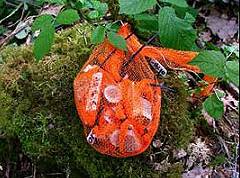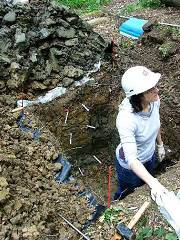Summary
Main study aims
- To undertake the burial, recovery and analysis of a variety of modern analogue materials and develop methods for monitoring their rates of degradation.
- To develop methodologies for monitoring the archaeological burial environment, directly correlating material degradation both with its immediate burial environment and the parallel soil mineral weathering study.
- To identify any possible correlation between material degradation and the burial environment, and evaluate any potential influences on the preservation of archaeological remains in situ.
This work builds upon the research into the weathering rates of minerals found within forest soils (above).
 In 2005 sets of iron, copper, red deer antler, cattle horn and cotton samples were buried at three depths, down to one metre, within soil horizons already being monitored by Forest Research. The materials chosen represent a selection of materials found in archaeological artefacts and they range both in their degradation mechanisms (chemical, physical and biological) and their susceptibility to degradation.
In 2005 sets of iron, copper, red deer antler, cattle horn and cotton samples were buried at three depths, down to one metre, within soil horizons already being monitored by Forest Research. The materials chosen represent a selection of materials found in archaeological artefacts and they range both in their degradation mechanisms (chemical, physical and biological) and their susceptibility to degradation.
Results to date
The first set of buried samples were recovered in 2006. Even after only six months, all the analogue materials display some differences between the soil horizons.
To date, the length of burial period and analyses are not sufficient to consider the effects of land use on the preservation of archaeological remains in situ. The last set of samples were retrieved in 2007 and the environmental monitoring data for the period will be analysed for trends during 2008.
Alongside this, geochemical modelling will be undertaken using the chemistry of the soil solutions (derived from the burial horizons) to simulate the reaction paths of the minerals in the analogue materials. It will provide an indication of the likely minerals that could occur in these burial conditions (and hence what material survives) and it will be compared to the actual results observed for the analogue materials. Such information may allow archaeologists to examine a simple soil solution and potentially predict what types of archaeological materials may survive on a site, or what may have been lost. In turn, this would guide the prioritisation of costly excavations and aid site interpretation.
Contact
The Woodland Burial Study is a collaborative project between archaeological conservators (led by Karla Graham from English Heritage) and Forest Research (Peter Crow – woodland geoarchaeologist).
Peter Crow
Forest Research
Alice Holt Lodge
Farnham
Surrey GU10 4LH
Tel: 01420 526168
Fax: 01420 23653
Email: peter.crow@forestry.gsi.gov.uk

